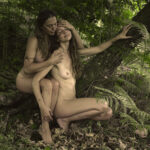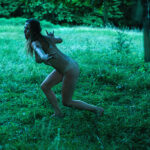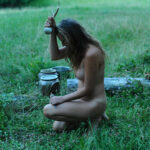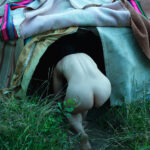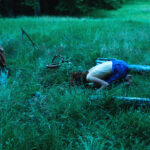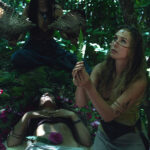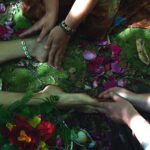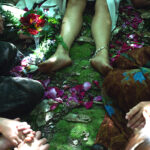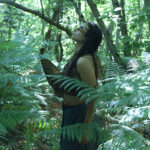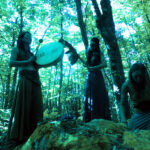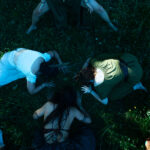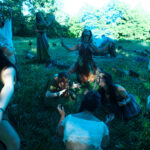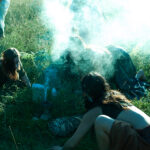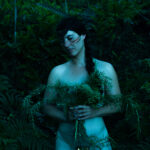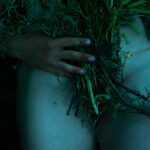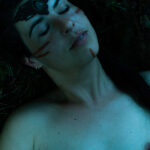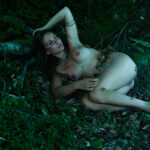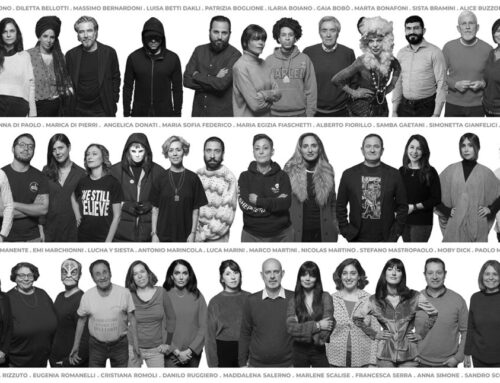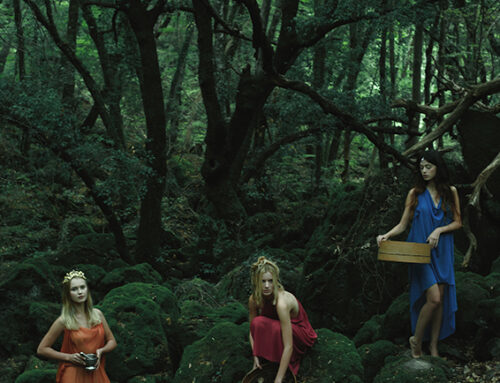Project Description
È una bellissima giornata di sole, rara da queste parti. La comunità che mi ospita vive in una costruzione tutta di legno, rinnovata recentemente con criteri architettonici altamente sostenibili, al centro di un bosco alle pendici dei Pirenei. È una comunità al femminile. Da quando sono arrivato ho contato una dozzina di donne che compaiono all’improvviso da stanze in penombra o direttamente dai campi, sempre sorridenti ed accoglienti. Lavorano, scalze ed iperattive. Spostano massi, zappano, cucinano, percorrono sentieri nei boschi alla ricerca di erbe e quant’altro. Lucy una ragazza francotedesca, dolcissima che sembra tirata fuori da un filmato vintage su Woodstock, cucina per la comunità leccornie vegane. Verso notte arrivano canti dal salone di sopra: Un suono di chitarre e flauti interrotto ogni tanto dal cupo rimbombo di un gong. Un paio di uomini, appaiono di contorno, non particolarmente considerati. Sono arrivato qui per l’invito di Alexadra Mogos, una mia amica di vecchia data, che si è trasferita in questa zona dopo essersi specializzata in riti ed erbe curative. Ha studiato in Sudamerica sotto la guida di uno sciamano (autore del testo che accompagna le immagini). Abbiamo pensato di ricreare insieme una summa di rituali al femminile che io fotograferò. Durante il sopralluogo nel bosco incontriamo are circolari, capanne indiane, nastri propiziatori appesi a rami, circoli di pietre in centri benedetti e, sparse nella boscaglia, alcune tende di campeggiatori solitari. Il giorno scelto per il rito è pieno di luce.. Per ora la cosa che più mi colpisce è questo continuo stridore di voci femminili. Risate e gridolini, come in un film di Shirin Nishat o la voce della Sara Felicita di Jodorowsky. Un linguaggio altro, quello delle fate, delle sirene o delle arpie. Mentre ci avviciniamo al luogo prescelto le vedo trascinare tronchi per preparare il fuoco sacro, a piedi nudi su stradine sterrate piene di sassi acuminati, per me dolorosi da percorrere persino con le mie scarpe robuste. Sono piedi forti, tozzi, radicati alla terra. Abituati al dono. Guarderò i piedi e le mani, gli occhi i gesti, le forme ruvide, o morbide, necessarie, o casuali, di queste donne per la durata intera del rito (circa 14 ore) fino a quando il fuoco non si spegnerà volontariamente nella notte pirenaica. Le guarderò come un fantasma assente. Le vedrò gioire, pregare, ringraziare, bere, accogliere, danzare e cantare, soprattutto cantare e danzare, spogliandosi come per un comando superiore non appena la luce si fa ombra. I riti del cioccolato, del tabacco, della fertilità e del Temazcal, scorrono in sequenza lenta, succedendosi con una naturalezza aumentata di ora in ora, fino al gran ballo finale intorno al fuoco. Poi piano piano le 11 fate tornano nelle loro spoglie mortali e lievemente, a piccoli gruppi, spariscono via lasciandomi questo vago ricordo di aver sognato.
In the Ariegeoise Pyrenees, and now I am staying in a monastic room in Manaska. It is a beautiful sunny day, uncommon in the surroundings. The community that hosts me lives in a wooden building, recently renovated with highly sustainable architectural criteria, just in the middle of a forest on the slopes of the Pyrenees. It is a feminine community. Since I arrived, I have counted a dozen women who suddenly appear from dark rooms, or directly from the fields, always smiling and welcoming. They work, barefoot and hyperactive. They move boulders, hoe, cook, walk along paths in the woods in search of herbs, and so on. Lucy, a very sweet French- German girl who seems to have been pulled out of a vintage film on Woodstock, cooks vegan delicacies for the community. At night, from the living room above descend songs: a sound of guitars and flutes, interrupted every now and then by the dull rumble of a gong. A couple of men appear on the side, not taken into particular consideration. I came here at the invitation of Alexadra Mogos, a longtime friend of mine, who moved to this area after specializing in healing rituals and herbs. She studied in South America under the guidance of a shaman (the author of the text accompanying the images). We decided to recreate together a summa of the feminine rituals that I will photograph. During the inspection in the woods, we encounter circular altars, Indian huts, propitiatory ribbons hanging from branches, stone circles in blessed places, and, scattered in the bushes, some tents of solitary campers. The day chosen for the ritual is full of light… So far, what strikes me most is this constant shrieking of female voices. Laughter and cries, like in a Shirin Nishat’s film, or the voice of Jodorowsky’s Sara Felicita. A different language, one belonging to fairies, mermaids, or harpies. As we approach the chosen place, I see them dragging logs to set the sacred fire, barefoot on unpaved paths full of sharp stones, which are painful to me to walk on, even with my sturdy shoes. Strong, stocky feet, rooted in the earth. Feet used to give. I will look at these women’s feet and hands, eyes, gestures, at their shapes – may them be rough, or soft, necessary, or casual – for the entire duration of the rite (fourteen hours, more or less) until the fire will willingly fade out in the Pyrenean night. I will look at them as if I were an absent ghost. I will see them rejoice, pray, thank, drink, welcome, dance and sing, especially dance and sing, undressing at a higher command, as soon as the light shifts into shadow. The rites of chocolate, tobacco, fertility, and Temazcal flow in a slow sequence, following each other with a naturalness increasing hour after hour, until the final grand dance around the fire. Then, slowly, the eleven fairies return to their mortal remains, and lightly, in small groups, fade away, leaving me with this vague memory of a dream.



